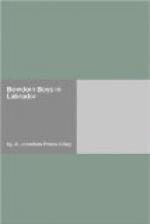[Grand Falls] The falls proper are three hundred and sixteen feet high, and just above the river narrows from two hundred and fifty to fifty yards, the water shooting over a somewhat gradual downward course and then plunging straight down with terrific force the distance mentioned, and with an immense volume. The river is much higher at times and the fall must be even grander, for while the party was there the ground quaked with the shock of the descending stream, and the river was nearly at its lowest point. At the bottom is a large pool made by the change of direction of the river from south at and above the falls to nearly east below. The canon begins at the pool and extends as has been described, with many turns and windings, for twenty-five miles through archaic rock. Above the falls in the wide rapids, the bed was of the same rock, which seems to underlie the whole plateau. In 1839, the falls were first seen by a white man, John McLean, an officer of the Hudson Day Co., while on an exploring expedition in that “great and terrible wilderness” known as Labrador. His description is very general, but he was greatly impressed with the stupendous height of the falls, and terms it one of the grandest spectacles of the world. Twenty years later, one Kennedy, also an employe of the Hudson Bay Co., persuaded an Iroquois Indian, who did not share the superstitious dread of them common among the Labrador Indians, to guide him to the thundering fall and misty chasm. He left no account of his visit, however, and in fact, though one other man reached them, and Mr. Holmes, an Englishman, made the attempt and failed, no full account of the falls has been given to the world, until Cary and Cole made their report. Above the falls as far as could be seen, all was white water, indicating a fall of about one hundred foot per mile. In the course of twenty-five or thirty miles there is a descent of twelve hundred feet, nearly equal to the altitude of the “Height of Land,” as the interior plateau of Labrador is called, which




